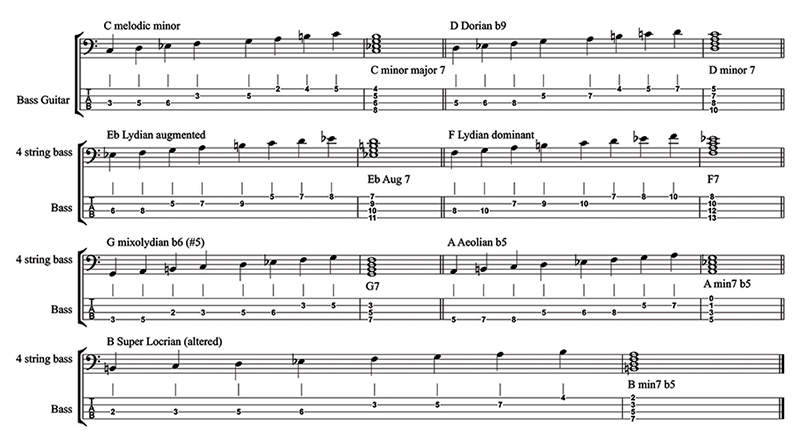Deep Thinking: Building Basslines – Part 2
Deep Thinking: Building Basslines – Part 2
Following on from the last two Deep Thinking online columns here we continue the quest to build a unique bassline, whether from a chord chart or from a songwriter playing a chord sequence to you.
We have previously looked at pentatonic scales and modes built from the major scale, both sets of which give plenty of freedom to break away from the standard ‘sticking to the root note’ stuff (although there is nothing wrong with that if that’s what’s required).
These modes, commonly known as the ‘jazz modes’, are built from the melodic minor scale but, unlike the one used by our classical mates in which the first mode ascends as a major scale with a minor third and then descends with a b7 and b6 (Aeolian), this one simply goes up and down with a minor third.
But here’s the interesting part. The mere changing of that one note means that the modes that follow become very varied in the sounds they produce. If we look at the second mode, D Dorian b9, we see that it is the same as the Dorian scale with which we are already familiar except for the b9 (minor second). It gives us a slightly exotic sound. In fact, by following this process along all the steps of the melodic minor scale, they all, as with the modes we last looked at, provide different musical ‘moods’.
I have placed an arpeggio, or chord, at the end of each scale to give an idea of what chord each mode scale will work with, but as long as you remain in a central key area, in this case C melodic minor, you can mix the scales when you are bassline building or soloing.
One of my favourites is the final mode, often known as ‘altered’ but our classical mates prefer the name ‘super locrian’. I used to joke with my mates that it was the ideal scale for an endless bass solo because it starts on the major 7, has a minor 3rd, a b5, a b7 and never seems to resolve. It’s most often used in jazz-oriented stuff. Anyway, try these modes out. They work in all keys. They won’t suit everything you do but they certainly add a difference from what we have already looked at.
Dr. Rob Burns is an Honorary Associate Professor in Music at the University of Otago in Dunedin. As a former professional studio bassist in the UK, he performed and recorded with David Gilmour, Pete Townsend, Jerry Donahue, Isaac Hayes, James Burton, Ian Paice and Jon Lord, Eric Burdon and members of Abba. He played on the soundtracks on many UK television shows, such as Red Dwarf, Mr. Bean, Blackadder and Not The Nine O’Clock News. Rob is currently a member of Dunedin band, The Verlaines and is on three progressive rock albums recently released in the UK, with other recordings available on Seelie Court Records (UK).

